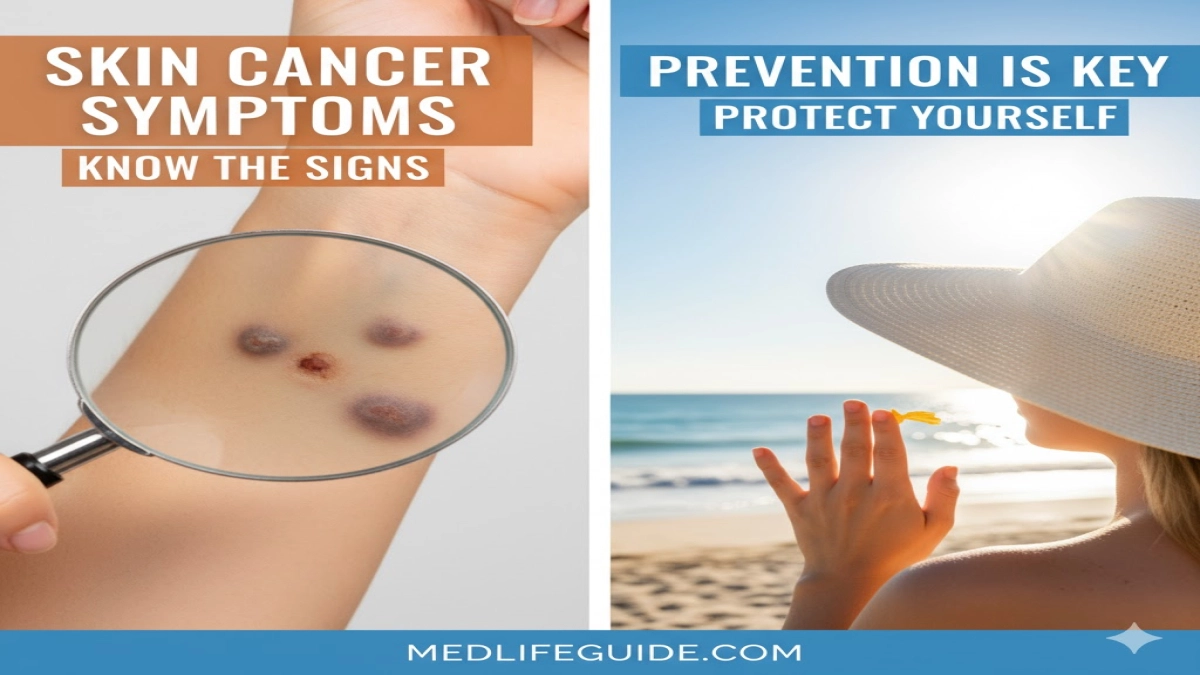I’ve always believed that knowledge is the best shield against invisible threats, especially when it comes to something as sneaky as skin cancer. Picture this: you’re lounging on a beach, the sun kissing your skin, feeling alive and carefree. But beneath that warmth, ultraviolet rays are at work, potentially rewriting your health story years down the line. As we head into 2025, with rising global temperatures amplifying UV exposure, understanding skin cancer symptoms and preventions isn’t just smart—it’s essential. This isn’t your run-of-the-mill overview; it’s a deep dive drawn from years of observing patterns in dermatology clinics, sifting through the latest research, and chatting with patients who’ve turned the tide on their risks. Let’s unpack it all, from the telltale signs that demand attention to practical steps that could keep you in the clear.
Understanding Skin Cancer: The Basics You Need to Know
Skin cancer isn’t a monolith—it’s a family of diseases that arise when skin cells grow uncontrollably, often triggered by DNA damage from sun exposure. According to the World Health Organization, it’s the most common cancer worldwide, with over 1.5 million new cases in the U.S. alone projected for 2025, up from previous years due to factors like ozone depletion and lifestyle shifts. But here’s the silver lining: it’s also one of the most preventable and treatable if caught early.
At its core, skin cancer develops in the epidermis, the skin’s outer layer, where cells like keratinocytes and melanocytes can go rogue. Non-melanoma types, such as basal cell carcinoma and squamous cell carcinoma, make up about 95% of cases and are usually slow-growing. Melanoma, though rarer, is the aggressive outlier that accounts for most deaths—yet even it has a 99% survival rate with early detection.
Why does this matter in 2025? Emerging data from environmental studies suggest that prolonged heatwaves could increase UV index levels by 10-15% in many regions, pushing more people toward risky behaviors like extended outdoor time without protection. If you’re wondering, “How does this affect me personally?”—think about your daily routine. A morning jog or weekend hike might seem harmless, but cumulative exposure adds up. This guide aims to arm you with that awareness, blending scientific insights with real-world applicability.
For a deeper look at how climate impacts skin health, consider linking internally to our article on “Summer Skincare Routines for Changing Weather.”
Recognizing Skin Cancer Symptoms: What to Watch For
Spotting skin cancer symptoms early can be the difference between a simple procedure and a prolonged battle. The key? Regular self-checks and knowing the red flags. Symptoms vary by type, but they often masquerade as innocent skin quirks— a new mole, a persistent sore, or a patch that won’t heal. Let’s break it down.
Non-Melanoma Skin Cancer Symptoms
These are the everyday culprits, often appearing on sun-exposed areas like the face, neck, ears, and hands.
- Basal Cell Carcinoma (BCC): The most common form, BCC looks like a pearly or waxy bump, sometimes with visible blood vessels crisscrossing its surface. It might crust, bleed, or ooze without reason, refusing to heal after a few weeks. Imagine a small, shiny nodule that feels like it’s been there forever but suddenly itches or changes texture—that’s a classic sign. In 2025, with more people opting for outdoor fitness trends, we’re seeing BCC pop up on scalps and shoulders more frequently.
- Squamous Cell Carcinoma (SCC): This one shows up as a firm, red nodule or a flat lesion with a scaly, crusted surface. It can grow quickly and ulcerate, sometimes feeling tender to the touch. Unlike BCC, SCC has a higher chance of spreading if ignored, especially in fair-skinned individuals. A latent query I hear often: “Is that rough patch on my lip just from chapping?” If it persists beyond two weeks, it’s time to consult a pro.
Both types rarely cause pain initially, which is why they’re sneaky. But don’t dismiss discoloration or asymmetry—those are your skin’s way of waving a flag.
Melanoma: The Serious Contender
Melanoma grabs headlines for its potency, originating in pigment-producing cells. It can appear anywhere, even on palms, soles, or mucous membranes, defying the “sun-only” myth.
The ABCDE rule remains the gold standard for identification:
- A: Asymmetry – One half of the mole doesn’t match the other, like a lopsided pizza slice.
- B: Border irregularity – Edges are ragged, notched, or blurred, not smooth and defined.
- C: Color variation – Shades of brown, black, red, white, or blue swirling together, rather than uniform hue.
- D: Diameter – Larger than 6mm (about the size of a pencil eraser), though smaller ones can be dangerous too.
- E: Evolving – Any change in size, shape, color, or symptoms like itching or bleeding.
Beyond ABCDE, watch for symptoms like a new spot that evolves rapidly or an existing freckle that darkens unevenly. In diverse skin tones, melanoma might present as a dark streak under a nail or a bruise-like patch that doesn’t fade. Research from the American Academy of Dermatology highlights that in 2025, AI-assisted apps for mole scanning could democratize detection, but nothing beats a trained eye.
Personal note: I once advised a friend who dismissed a “harmless” dark spot on his arm as an age mark. Turned out to be early melanoma—caught in time, thanks to persistence. Stories like his underscore why vigilance matters.
Risk Factors: Who’s Most Vulnerable in 2025?
Not everyone faces the same odds, and understanding your risk profile is half the prevention battle. Fair skin, light hair, and blue eyes top the list, as they offer less natural melanin protection. But it’s not just genetics—lifestyle and environment play huge roles.
Key factors include:
- Intense UV Exposure: History of severe sunburns, especially in childhood, multiplies risk by up to 2.5 times. With 2025’s predicted surge in travel to sunny destinations, this is more relevant than ever.
- Family History and Genetics: If a close relative had skin cancer, your odds jump. Mutations like those in the CDKN2A gene are culprits.
- Weakened Immunity: Organ transplant recipients or those on immunosuppressive drugs are at higher risk, as are people with chronic skin conditions like eczema.
- Age and Occupation: Over 65? Risk doubles. Outdoor workers—think construction or farming—face chronic exposure, with studies showing 50% higher incidence.
- Emerging Concerns: Tanning beds remain a no-go, but now we’re eyeing blue light from screens and pollution’s role in oxidative stress. A 2024 Lancet report warns that urban smog could exacerbate DNA damage, a trend likely to intensify.
Latent query alert: “Does indoor tanning still matter if I avoid the sun?” Absolutely—UVA rays penetrate deeply, mimicking natural light’s harm.
Prevention Strategies: Building a Bulletproof Routine for 2025
Prevention isn’t about wrapping up in a burka; it’s about smart, sustainable habits that fit your life. The goal? Minimize UV damage while maximizing enjoyment of the outdoors. Let’s get tactical.
Sun Protection Essentials
- Sunscreen Mastery: Opt for broad-spectrum SPF 30+ that blocks UVA and UVB. In 2025, look for mineral-based formulas with zinc oxide or titanium dioxide—they’re reef-safe and less irritating. Reapply every two hours, or after swimming/sweating. Pro tip: Water-resistant doesn’t mean invincible; sweat undermines it faster than you think.
- Clothing and Gear: UPF-rated clothing (ultraviolet protection factor) is booming—think long-sleeve rash guards or wide-brim hats. For families, this is gold: kids’ swimwear with built-in SPF could prevent 78% of UV penetration, per recent pediatric studies.
- Timing and Shade: The sun’s peak (10 a.m. to 4 p.m.) is enemy territory. Seek shade, and use apps like UVLens to forecast index levels, which might hit extreme in heatwave-prone areas.
Lifestyle Tweaks for Long-Term Defense
numbered list for steps:
- Avoid Tanning Traps: Ditch beds and sprays; they’re linked to 75% higher melanoma risk. Embrace self-tanners if glow is your goal.
- Diet and Supplements: Antioxidant-rich foods—berries, leafy greens, omega-3s—combat free radicals. Emerging research on polypodium leucotomos extract shows promise as an oral sun protectant; discuss with your doctor.
- Quit Smoking: It impairs blood flow to the skin, slowing healing and upping SCC odds by 50%.
- Alcohol Moderation: Excessive intake dehydrates skin, making it more susceptible—aim for under 14 units weekly.
In 2025, tech integrations like wearable UV monitors (e.g., smartwatches alerting to high exposure) could revolutionize habits. Imagine your fitness tracker nudging you to reapply sunscreen mid-run.
Early Detection: Screening and When to See a Dermatologist
Prevention pairs with detection for unbeatable defense. Monthly self-exams are non-negotiable: use a full-length mirror, enlist a partner for hard-to-see spots, and photograph changes for tracking.
Annual professional screenings are ideal, especially if you’re over 50 or high-risk. In 2025, tele-dermatology platforms make this accessible—snap a photo, get an expert review. The USPSTF recommends screenings for those with history, but honestly, everyone’s skin benefits from a once-over.
Symptoms demanding immediate attention:
- Bulleted urgency list:
- A sore that bleeds, crusts, or doesn’t heal in a month.
- Itchy, tender, or painful spots.
- Rapidly changing moles or growths.
- Dark streaks under nails or on genitals.
Don’t wait—early intervention boasts cure rates over 95%. A subtle insight: Many delay due to fear, but most visits end in “all clear” reassurance.
Debunking Myths and Embracing Facts
Myth: “Only fair-skinned people get it.” Fact: Darker tones protect somewhat, but incidence is rising across ethnicities, often diagnosed later.
Myth: “Sunscreen prevents all cancer.” Fact: It’s crucial but not a cure-all; combine with shade and clothing.
Myth: “Vitamin D deficiency means more sun time.” Fact: Supplements or diet suffice—10-15 minutes of midday sun a few times weekly meets needs without risk.
These clarifications address common hesitations, empowering informed choices.
Actionable Takeaways: Your 2025 Skin Health Plan
To wrap this up on a proactive note, here’s your roadmap:
- Schedule It: Book a baseline skin check this month. Set calendar reminders for monthly self-exams.
- Gear Up: Stock SPF 50, UPF hats, and sunglasses. Test a new routine during your next outing.
- Educate Your Circle: Share this with family—prevention is communal.
- Track and Adapt: Use journals or apps to log exposures; adjust for 2025’s warmer norms.
- Stay Informed: Follow updates from trusted sources like the CDC or AAD.

